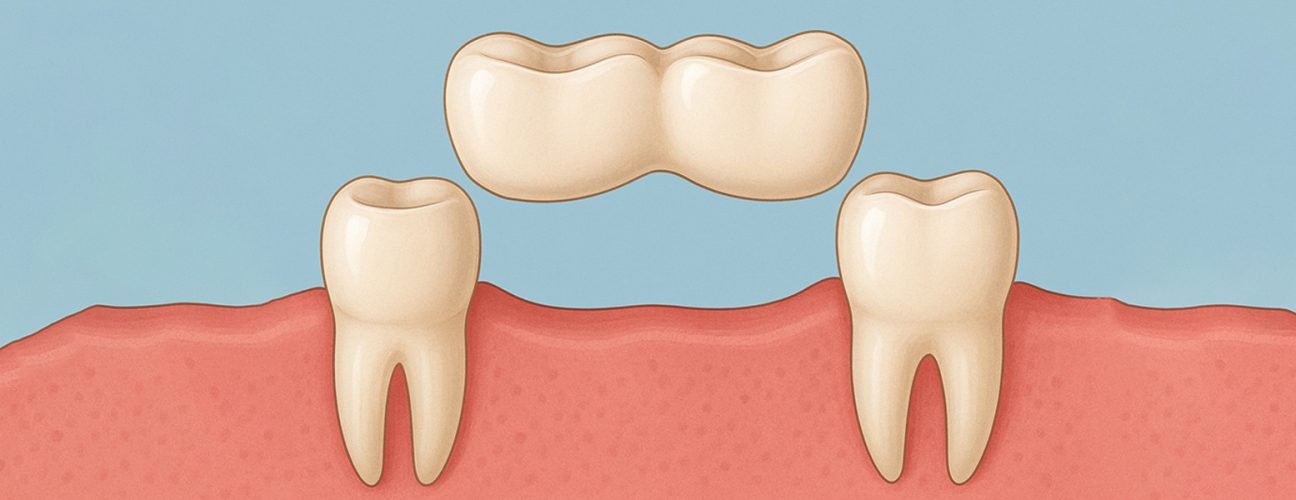Missing a tooth? You’re not alone. Whether it’s from injury, decay, or age, losing a tooth can mess with your smile, speech, and even how you eat. That’s why finding the right tooth replacement options matters. Two of the most talked-about fixes? Dental bridges and implants. But which one’s best for you?
Let’s break it down so you can walk into your next dental visit confident and informed.
What Is a Dental Bridge?
Think of a dental bridge as a literal “bridge” for the gap your missing tooth left behind.
- It uses the two teeth next to the gap (called abutment teeth) to support an artificial or false tooth in the middle.
- The dentist reshapes those surrounding teeth and caps them with crowns to hold everything in place.
- You’ll end up with a row of connected teeth—one fake, two real ones holding it together.
Types of dental bridges:
- Traditional bridge: The most common. Anchored to two natural teeth.
- Cantilever bridge: Only uses one tooth as support.
- Maryland bridge: A framework made of metal or porcelain is used to hold the bridge.
- Implant-supported bridge: Combines implant benefits with bridge design.
Best for:
- Individuals with healthy teeth on either side of the gap
- Those looking for a quicker, non-surgical fix
What Is a Dental Implant?
A dental implant is more like a full tooth replacement, from root to crown.
Here’s how it works:
- A titanium post is surgically or clinically placed into your jawbone.
- Over time, it fuses with the bone—a process called osseointegration.
- Post-healing, a crown is placed on top, mimicking your natural tooth.
This method doesn’t rely on nearby teeth. It stands alone and strong.
Best for:
- People with healthy gums and bone structure
- Those looking for a long-term solution
Bonus: One of the biggest dental implant benefits is that they stimulate jawbone growth and prevent facial sagging.
Durability and Longevity
Let’s talk about staying power.
- Dental bridges usually last around 5–15 years. With excellent care, they can push 15+.
- Implants, on the other hand, can last 20+ years. Some even last a lifetime with proper maintenance.
Factors that matter:
- Daily oral hygiene
- Material quality
- Your bite alignment
- Regular dentist visits
So, if you’re in it for the long haul, implants might just win this round.
Aesthetic and Functional Differences
This one’s about looks and feels. Because let’s face it—you want your new tooth to blend in and feel natural.
- Dental bridges can look great, especially with modern porcelain options, but they might feel a little bulkier.
- Implants look, feel, and function almost exactly like real teeth.
Everyday comfort:
- Chewing? Easier with implants.
- Talking? Both do the job, but implants feel more seamless.
For those who want a tooth that “disappears” into their smile, implants might be the top pick.
Cost Considerations
Money talks. But so does long-term value.
- Bridges are typically more affordable upfront.
- Implants cost more, but you’re paying for longevity, bone support, and fewer replacements.
Keep in mind:
- Insurance may cover bridges more often.
- Some implant costs are out-of-pocket.
Pro tip: Check if your family dentist in Gahanna offers payment plans or financing options. Long-term investment often pays off in fewer future procedures.
Procedure Time and Recovery
Time is precious. How long do these take?
Bridges:
- Usually 2–3 visits
- Quick placement once teeth are prepped.
Implants:
- Multi-stage process
- Healing time (3–6 months) between the implant post and the crown
If you’re in a hurry, a bridge is faster. But if you’re thinking long-term, implants are worth the wait.
Impact on Adjacent Teeth
Here’s something people often overlook.
Dental bridges require grinding down neighboring teeth to place crowns. That means altering perfectly healthy teeth.
Implants?
- They leave adjacent teeth alone.
- That means more natural tooth structure stays untouched.
Less damage today = fewer problems tomorrow. Your future self will thank you.
Maintenance and Oral Hygiene
Taking care of your replacement is just as important as getting it.
Bridges:
- Flossing can be tricky—you’ll need special tools.
- Food may get stuck under the bridge if not cleaned well.
Implants:
- Just brush and floss like a real tooth.
- Lower risk of decay—but gum care is crucial.
Neglecting either can lead to trouble. But implants tend to be lower maintenance once you’ve healed.
Suitability Based on Bone Health
This one’s big—literally.
Implants need solid bone to anchor.
- If bone loss has occurred, you may need bone grafting first.
- Not everyone is a candidate without that extra step.
Bridges don’t need bone support.
- They sit on top, so they’re great for patients with weaker jawbone density.
If your dental office has advanced imaging, it can help decide what’s possible for your unique smile.
Looking for a dental office open late? Visit The Smile Method, we are open till 8 PM.
Final Thoughts
Both bridges and implants have their place. It’s not about one being better—it’s about what fits your life, health, and smile goals. Some want speed. Others want something permanent. That’s where your dentist comes in.
At The Smile Method Gahanna, we help patients make informed decisions every day.
Still unsure? Book a consultation, and let’s talk it through together.

